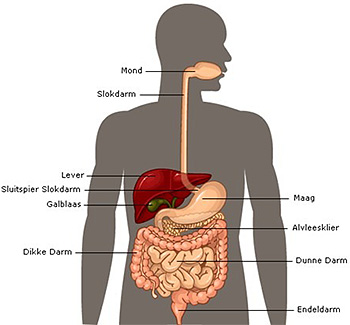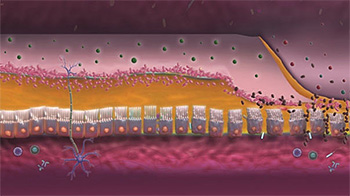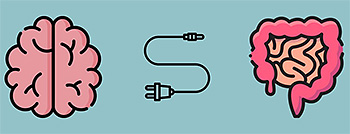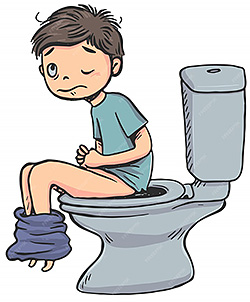Formula products for the intestinal tract

- Gut Formula
- Contains licorice, marshmellow extract, slippery elm and aloe vera

- Gut Formula
- Contains L-glutamine, fiber, curcuma, boswellia and aloe

- Gut Formula
- Contains amino acids, vitamins, minerals, herbs and bacteria strains
4 Best Supplements for the Gut







Buy the best supplements for the Intestines here. Or find answers to all your questions about this below.
The gut (or bowels or intestines) comprises an important part of our digestive system. The intestines are located at the end of the digestive tract: at the lower end of the abdomen we find the small intestine and the large intestine. The small intestine consists of the duodenum, the jejunum and the ileum, which is the last part of the small intestine.

The large intestine has a larger diameter than the small intestine. Where the ileum passes into the large intestine lies the appendix, this is usually on the right side of the abdomen. The large intestine consists of the colon, rectum and anal canal.
Function
The intestines operate on the last part of digestion and are responsible for the absorption of nutrients. The jejunum absorbs most nutrients: carbohydrates, fats, minerals, proteins and vitamins. The lowest part of the small intestine is the ileum. This is where the last parts of digestion take place. This is where bile acids and fluid are absorbed as well as vitamin B12.
The small intestine is folded and because of this, it has a large surface area to ensure that the absorption of nutrients occurs properly. Next, the substance that remains, the residue, passes to the large intestine.
The liver, gallbladder and pancreas are part of the digestive system and are closely connected to the small intestine.
The lining of the small intestine consists of a mucous membrane of similar structure to the digestive tract in the upper regions. The absorbent surface of the small intestine is enlarged by folds such as villi and microvilli.
The mucosa of the small intestine contain exocrine cells, these secrete mucus and enzymes. In addition, there are endocrine cells, these secrete hormones.
The amount of secretion is related to the size of the gastric pulp (chyme). This is largely a reflex reaction and mostly occurs locally.
Unlike the small intestine, the colon does not produce digestive enzymes. Chemical digestion is completed in the small intestine before the mush of digested food reaches the large intestine. Functions of the large intestine include absorption of water and electrolytes and elimination of feces.
Barrier
Our intestines do not only have the function to absorb nutrients, they also ensure that certain substances are are specifically nót absorbed. In general, substances that are too large are not absorbed through the cells of the intestinal lining.

In between the intestinal wall cells the tight junctions are located, which are a type of sliding doors that regulate the permeability of the intestinal wall. They prevent substances that are too large, such as proteins, from passing the intestinal cells Proteins must first be broken down properly by enzymes into smaller amino acids. These can pass through and then reach their destination by means of the blood.
Hyperpermeable intestine
If the tight junctions are damaged by inflammation, for example - due to stress, highly processed diet or by restless intestines (imbalance) - then the permeability of the intestinal wall becomes increased. This means that the tight junctions are too open and that oversized substances can be absorbed. Also proteins that have not yet been cut up into amino acids. Precisely those proteins can be the problem, because the immune system basically does not react to amino acids but does respond to proteins. In fact, pathogenic viruses and bacteria are also made up of entire proteins.
When the tight junctions are opened too much, it is more likely that the immune system will have to act more often,when it may not need to at all. But the immune system signals a protein and goes after it. That is technically a false alarm, but it is one of the causes of low-grade inflammation in the gut. Every time the immune system gets activated, it requires energy. In addition, it will also stimulate the development of allergic reactions.
Control of intestines
The intestines are part of the digestive system and are controlled by the parasympathetic nervous system. The nervus vagus is the main cranial nerve that controls the intestines. It stimulates the activity of the smooth muscle tissue and thus ensures peristalsis; it also controle that the glands of the intestines produce sufficient fluids.
Hormones also affect the secretion of secretions and the motility of the intestines. GLP-1 and GLP-2 are examples of intestinal hormones. GLP-1 inhibits appetite and GLP-2 promotes the growth of intestinal cells and action of the intestines.
Gut microbiome
Most of our gut microbiome is located in the large intestine. It consists of billions and billions of micro organisms including viruses, parasites and fungi. Each individual has a unique composition.
Coli bacteria are one of the most abundant bacteria species in the colon, producing vitamin K as a waste product of metabolism.
Our gut microbiome has several functions, in addition to absorption of the final nutrients, the microbiome is important for the stimulation of our immune system and the production of neurotransmitters. Probiotics (literally "in favor of life") consist of beneficial living bacteria found in our intestines like for example Lactobacillus salivarius.
Prebiotics (literally "benefit for life"). Prebiotics are nourishment for your intestinal flora. They allow the beneficial bacteria to multiply better and thrive into a strong colony.
Gut-brain axis

The gut and the bacteria that live in the gut produce all kinds of substances that affect the brain. This can be both positive and negative. A healthy gut flora produces neurotransmitters that affect your behavior, your feelings and your concentration. Examples of the neurotransmitters are: dopamine, serotonin, acetylcholine and GABA.
Poorer gut condition can lead to concentration problems and neuroinflammation (inflammation in the brain).
The connection between the brain and gut is also called the gut-brain axis.
Nutrients that benefit the intestines
At the core of a balanced gut flora is your diet. It is good to bear in mind that in this respect variation is important. Basically, there are 2 types of nutrients that make our gut bacteria happy: fibers and antioxidants. Both are found particularly in fruits and vegetables!
Many people use all sorts of substances such as L-glutamine, quercetin, cranberry and black cumin, or certain teas that are supposed to be good for the intestines. Because EU approval of claims on this subject is pending, we may not further comment on this. If you would like to have advice for the benefit of your gut please ask our orthomolecular health practitioner.
Interesting facts

The time it takes for food to be fully processed by the body differs in men and women. Women take 72 hours on average while men take about 55 hours from mouth to butt. The length of the small and large intestine together is about 4.5 meters. The average surface area is about 260-300 square meters.
On average, an adult in the West produces 6,500 pounds of stool. This consists largely of dead bacteria, undigested fiber, removed intestinal cells and the remains of dead red blood cells.
Written by: Liesbeth Thoen
Edited by: Marcella van der Wel
Updated: July 16, 2024

